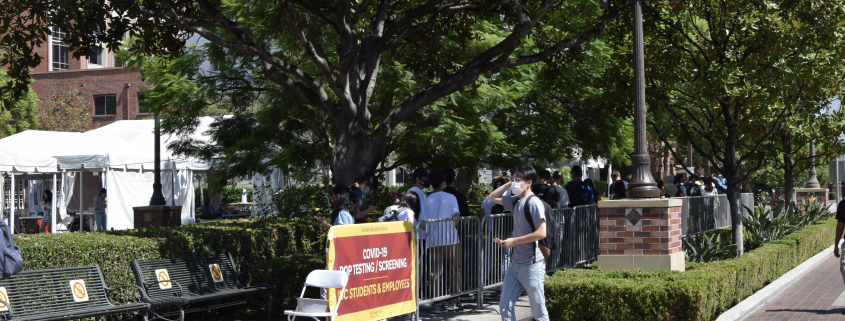USC reveals health recommendations for campus return

Amid slightly declining coronavirus case counts in Los Angeles County, USC Student Health announced the University’s health recommendations and requirements for the Fall 2022 in-person return to campus in a communitywide email Tuesday. Although the University has no plans to readminister regular surveillance testing, Student Health suggests that community members returning to campus test one to two days before traveling to USC and advises students to use the Student Health Pop Testing service three to five days after their arrival to campus.
Individuals who tested positive for the coronavirus within the last 90 days should not test via PCR test, including through Pop Testing. Masking is required on the premises of all testing sites.
While the University will not reinstate the indoor masking mandate for the fall, Student Health “highly recommends” wearing medical-grade masks or respirator masks indoors to reduce the risk of coronavirus infection, Chief Student Health Officer Dr. Sarah Van Orman said.
Collection kits and supplies for saliva sample collection will be available at move-in and testing sites around campus; drop-off of kits are to be scheduled through MySHR. Sites include the Eric Cohen Clinic at the Health Science Campus and UPC Jefferson/Parking.
Students with outstanding immunization requirements are encouraged to complete and upload their immunizations to MySHR before arriving on campus. Required immunizations must be uploaded by Sept. 9, and students using their own insurance plan to opt out of the Student Health Insurance Plan — which is applied automatically to all full-time students enrolled in on-campus programs — are required to upload their insurance waiver by the same date. Student Health will host the Immuchella immunization fair on campus between August 15 to 26 for students arriving from outside the United States.
The emergence of the highly transmissible BA.5 Omicron subvariant as the leader of infection in L.A. County, which saw 3,227 new reported cases as of Tuesday, has made a countywide indoor mask mandate likely in the coming weeks. The University will follow all L.A. County coronavirus guidelines and requirements if this category jump happens, including adhering to all masking and capacity requirements.
From July 17 to July 23, Student Health reported 91 students and 33 faculty infected, with positivity rates at 10.9% and 7.8%, respectively. The level of positive cases on campus, Van Orman said, is indicative of the infection rate in L.A. County — if certain variants are causing higher reinfection rates in L.A. County, the University will also see higher rates of positivity, she said. The national positive test rate on July 17 was 17.8%, indicating a rise since early June.
“We think we’re going to probably have a lot of cases that we don’t know about, but we still need to keep the overall levels down,” Van Orman said. “We’re unfortunately seeing people with the severe consequences of [reinfection].”
As the virus moves from a pandemic to an endemic state, Van Orman said, the U.S. is still seeing new variants emerge that continue to impact immunocompromised individuals, with hospitalizations doubling since May. The BA.4 and BA.5 wave has made clear that reinfection and more serious symptoms are feasible, especially among younger demographics, because the virus has adapted.
“We’re seeing fewer asymptomatic infections than we did [last winter], but we’re also seeing people, because [BA.4 and BA.5] appear to be escaping some of the immunity from natural infection and, to some degree, from vaccination, have more symptoms,” Van Orman said. “When we’re diagnosing it based on symptoms, we’re only seeing the people that we tested or that came in so … there were probably people for whatever reason that had such low viral loads that they didn’t even notice that they had an infection.”

